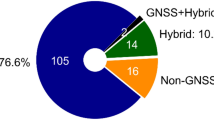Abstract
Recently, the research of dynamics and control of the satellite formation flying has been attracting a great deal of attentions of the researchers. The theory of the research was mainly based on Clohessy-Wiltshire's (C-W's) equations, which describe the relative motion between two satellites. But according to some special examples and qualitative analysis, neither the initial parameters nor the period of the solution of C-W's equations accord with the actual situation, and the conservation of energy is no longer held. A new method developed from orbital element description of single satellite, named relative orbital element method (ROEM), was introduced. This new method, with clear physics conception and wide application range, overcomes the limitation of C-W's equation, and the periodic solution is a natural conclusion. The simplified equation of the relative motion is obtained when the eccentricity of the main satellite is small. Finally, the results of the two methods (C-W's equation and ROEM) are compared and the limitations of C-W's equations are pointed out and explained.
Similar content being viewed by others
References
LIN Lai-xing. Study on virtual spacecraft composed by micro-spacecrafts formation flying[A]. In: LIN Lai-xing Ed.Proceedings of Micro-Spacecrafts Formation Flying and Application[C]. Beijing: Committee of Experts of National High Technology, Micro-Satellite Technology Group, July, 2002, 1–35. (in Chinese)
XIAO Ye-lun, ZHANG Xiao-ming. The dynamics characteristic and orbit design of micro-spacecrafts formation flying[A]. In: LIN Lai-xing Ed.Proceedings of Micro-Spacecrafts Formation Flying and Application [C]. Beijing: Committee of Experts of National High Technology, Micro-Satellite Technology Group, July, 2002, 133–144. (in Chinese)
David Folta, Francesco Bordi, Christopher Scolese. Considerations on formation flying separation for earth observing satellite missions[J]. AAS 92-144.Advances in the Astronautical Sciences, 1992,79 (2): 803–822.
David Weidow, John Bristow. NASA/DoD university nano-satellites for distributed spacecraft control[A]. In:SSC99-V-5 13th AIAA/USU Small Satellite Conference[C]. Logan, Utah, 1999, 23–26.
Clohessy W H, Wiltshire R S. Terminal guidance system for satellite rendezvous[J].Journal of the Aerospace Science, 1960,27, 653–674.
Yan Q, Kapila V, Sparks A G. Pulse-based periodic control for spacecraft formation flying[A]. In:Proceedings of the American Control Conference[C]. Chicago, Illinois, 2000, 374–378.
Kapila V, Sparks A G, Buffington J M,et al. Spacecraft formation flying: dynamics and control [A]. In:Proceedings of the American Control Conference [C]. San Diego, California, 1999, 4137–4141.
YANG Wei-lian. A new method to solve relative motion of satellite[J].China Space Science and Technology, 1999,20 (6): 20–26. (in Chinese)
ZHANG Xiao-min. Studies on dynamics and control of spacecraft relative orbital motion[D]. [Doctoral thesis]. Beijing: Beijing University of Aeronautics and Astronautics, 2000. (in Chinese)
ZHANG Ren-wei.Dynamics and Control of Orbit and Attitude of Spacecraft [M]. Beijing: Beijing University of Aeronautics and Astronautics Press, 1998, 1–7. (in Chinese).
GAO Yun-feng. The research of relative orbital dynamics of satellite formation flying[D]. [Doctoral thesis]. Beijing: Tsinghua University, 2001. (in Chinese)
YANG Jia-chi.Dynamics and Control of Orbit of Spacecraft[M]. Beijing: Aerospace Press, 1995, 52–54. (in Chinese)
CHENG Yu-shn, TANG Yun, ZHENG Zhao-chang, et al.The Advance Analysis Method for Non-Linear Dynamics[M]. Beijing: Science Press, 1992, 10–30. (in Chinese)
Author information
Authors and Affiliations
Additional information
Communicated by ZHENG Quan-shui
Foundation items: the National Natural Science Foundation of China (10202008); the Post-Doctoral Science Foundation of China ((2001)31)
Biography: GAO Yun-feng (1967≈), Associate Professor, Doctor (E-mail: gaoyunfeng@tsinghua.edu.cn)
Rights and permissions
About this article
Cite this article
Yun-feng, G., He-xi, B. & Jun-feng, L. Comparison of two methods in satellite formation flying. Appl Math Mech 24, 902–908 (2003). https://doi.org/10.1007/BF02446495
Received:
Revised:
Issue Date:
DOI: https://doi.org/10.1007/BF02446495
Key words
- satellite formation flying
- relative motion
- C-W's equation
- relative orbital element method
- periodic solution




